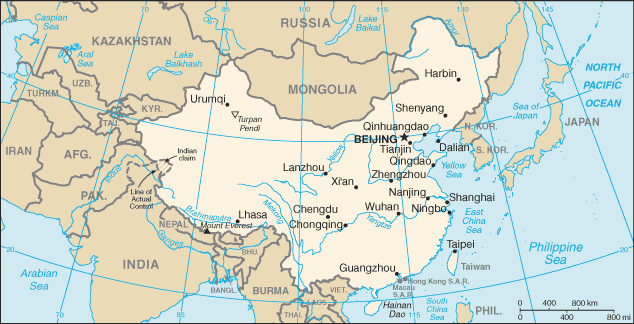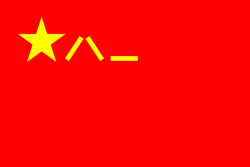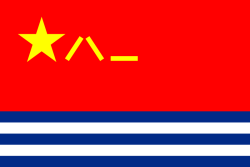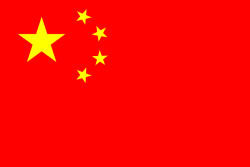The People's Republic of China
Related Categories:

 Chinese Military Flag
Chinese Military Flag |
 Chinese Naval Ensign
Chinese Naval Ensign |
Chinese Characters, Ba-Gua, Yin Yang, and a list of Links.
www.chinese-symbols.us/ China - Fotw
Interpretation of the Chinese Flag.
www.fotw.us/
Although China needs economic growth to spur its development, the government has begun to worry that rapid economic growth could negatively impact the country's resources and environment. Another concern is that many people are not benefiting from China's economic miracle.
en.wikipedia.org/wiki/
Ethnic Groups
The largest ethnic group is the Han Chinese, who constitute about 91.9% of the total population. The remaining 8.1% are Zhuang (16 million), Manchu (10 million), Hui (9 million), Miao (8 million), Uygur (7 million), Yi (7 million), Mongolian (5 million), Tibetan (5 million), Buyi (3 million), Korean (2 million), and other ethnic minorities.
Language
There are seven major Chinese dialects and many subdialects. Mandarin (or Putonghua), the predominant dialect, is spoken by over 70% of the population. It is taught in all schools and is the medium of government. About two-thirds of the Han ethnic group are native speakers of Mandarin; the rest, concentrated in southwest and southeast China, speak one of the six other major Chinese dialects. Non-Chinese languages spoken widely by ethnic minorities include Mongolian, Tibetan, Uygur and other Turkic languages (in Xinjiang), and Korean (in the northeast).
The Pinyin System of Romanization
On January 1, 1979, the Chinese Government officially adopted the pinyin system for spelling Chinese names and places in Roman letters. A system of Romanization invented by the Chinese, pinyin has long been widely used in China on street and commercial signs as well as in elementary Chinese textbooks as an aid in learning Chinese characters. Variations of pinyin also are used as the written forms of several minority languages.
Pinyin has now replaced other conventional spellings in China's English-language publications. The U.S. Government also has adopted the pinyin system for all names and places in China. For example, the capital of China is now spelled "Beijing" rather than "Peking."
Religion
Religion plays a significant part in the life of many Chinese. Buddhism is most widely practiced, with an estimated 100 million adherents. Traditional Taoism also is practiced. Official figures indicate there are 20 million Muslims, 5 million Catholics, and 15 million Protestants; unofficial estimates are much higher.
While the Chinese constitution affirms religious toleration, the Chinese Government places restrictions on religious practice outside officially recognized organizations. Only two Christian organizations--a Catholic church without official ties to Rome and the "Three-Self-Patriotic" Protestant church--are sanctioned by the Chinese Government. Unauthorized churches have sprung up in many parts of the country and unofficial religious practice is flourishing. In some regions authorities have tried to control activities of these unregistered churches. In other regions, registered and unregistered groups are treated similarly by authorities and congregations worship in both types of churches. Most Chinese Catholic bishops are recognized by the Pope, and official priests have Vatican approval to administer all the sacraments.
Population Policy
With a population officially just over 1.3 billion and an estimated growth rate of about 0.6%, China is very concerned about its population growth and has attempted with mixed results to implement a strict birth limitation policy. China's 2002 Population and Family Planning Law and policy permit one child per family, with allowance for a second child under certain circumstances, especially in rural areas, and with guidelines looser for ethnic minorities with small populations. Enforcement varies, and relies largely on "social compensation fees" to discourage extra births. Official government policy opposes forced abortion or sterilization, but in some localities there are instances of forced abortion. The government's goal is to stabilize the population in the first half of the 21st century, and current projections are that the population will peak at around 1.6 billion by 2050.
www.state.gov/r/
Introduction
About
Contact
Symbols in The News
Interpret this Symbol
AAC
African
AI
Alchemy
Alphabets
Ancient
Animal Symbolism
Architecture
Art
Articles
Astrology
Baha'i
Blissymbolics
Blueprint Symbols
Buddhist
Celtic Symbols
Cemetery
Chinese Symbols
Christian
Circle
City
Codes
Color
Conlangs
Crop Circles
Danger
Da Vinci Code
Designing Logos
Dictionaries
Dreams
Education
Egyptian Symbols
Electrical
Emoticons
Find Images
Fonts
Food
Fraternity
Hamsa
Healing
Heraldry
Hermetic
Highway Signs
Hindu
History
Hobo
Holiday
Icons
iConji
Islamic
Jain Symbols
Japanese, Kanji
Jewish
Justice
Law
Literary Symbolism
Mandalas
Map
Masonic
Math, Number
Meaning of Names
Medical
Middle East
Military
Miscellaneous
Money
Music
Mythology
Native American
Playing Cards
Power
Psychology
QiQiiKhu
Reiki
Religious
Runes, Norse
Sacred Geometry
Scientific
Science Fiction
Sorority
Sports
Symbols in the News
Tattoos
ThirteenSymbols
Tree of Life
Ursprache
Videos
Visual Languages
Weather
Web Codes
Wicca
Words
Writing Systems
Braille
Coinherence
Coptic
Cuneiform
Easter Island
Etruscan
Happy Human
Hebrew
Kokopelli
Linear B
Lotus
Love Symbols
Mandorla
Moon Alphabet
Nine Pointed Star
Om
Oz
Phonetic
Scarab Beetle
Silent
Theosophy
Unifon
About
Contact
Symbols in The News
Interpret this Symbol
AAC
African
AI
Alchemy
Alphabets
Ancient
Animal Symbolism
Architecture
Art
Articles
Astrology
Baha'i
Blissymbolics
Blueprint Symbols
Buddhist
Celtic Symbols
Cemetery
Chinese Symbols
Christian
Circle
City
Codes
Color
Conlangs
Crop Circles
Danger
Da Vinci Code
Designing Logos
Dictionaries
Dreams
Education
Egyptian Symbols
Electrical
Emoticons
Find Images
Fonts
Food
Fraternity
Hamsa
Healing
Heraldry
Hermetic
Highway Signs
Hindu
History
Hobo
Holiday
Icons
iConji
Islamic
Jain Symbols
Japanese, Kanji
Jewish
Justice
Law
Literary Symbolism
Mandalas
Map
Masonic
Math, Number
Meaning of Names
Medical
Middle East
Military
Miscellaneous
Money
Music
Mythology
Native American
Playing Cards
Power
Psychology
QiQiiKhu
Reiki
Religious
Runes, Norse
Sacred Geometry
Scientific
Science Fiction
Sorority
Sports
Symbols in the News
Tattoos
ThirteenSymbols
Tree of Life
Ursprache
Videos
Visual Languages
Weather
Web Codes
Wicca
Words
Writing Systems
Braille
Coinherence
Coptic
Cuneiform
Easter Island
Etruscan
Happy Human
Hebrew
Kokopelli
Linear B
Lotus
Love Symbols
Mandorla
Moon Alphabet
Nine Pointed Star
Om
Oz
Phonetic
Scarab Beetle
Silent
Theosophy
Unifon

